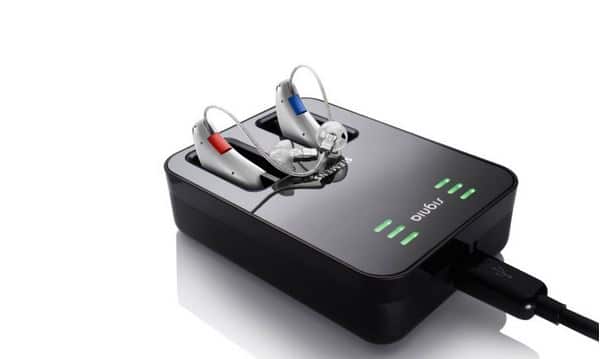by Eric Branda, AuD
Today’s hearing aids include a wide range of features that were unthinkable even a decade ago. Wireless connectivity for streaming TV, music, and phone calls, binaural processing, and remote tuning are just some of the things modern hearing aids can offer. But all of these cutting-edge features require more power consumption to work, putting greater demand on hearing aid batteries. Rechargeable hearing aids help in this regard.
Though they’ve been around for more than 10 years, new innovations, such as the lithium-ion (Li-ion) battery, provide wearers with an easy and convenient way to keep their hearing aids running all day, every day.
Why go rechargeable?
Rechargeable hearing aid batteries do more than just power hearing aids; they offer a wide range of benefits to hearing aid wearers. For one, they eliminate the need to regularly change batteries—an important feature for those with vision or dexterity issues who struggle with opening the tiny doors in their hearing aids or handling the small batteries. Along these lines, they also provide greater convenience, since you know once they’ve charged overnight your hearing aids will be ready to work all day long. Many rechargeables allow you to top off with a “quick charge” of an hour or less during the day that adds several hours of wearing time even if you’re streaming audio regularly.
They’re also easier on the wallet. Rechargeable hearing aids can last years, as opposed to the typical zinc-air batteries that need to be replaced weekly or every few days. And if you’re trying to be “greener,” rechargeable hearing aids are an environmentally friendly solution, preventing an average of 300 disposable hearing aid batteries over a three-year time span per person from ending up in landfills.
Three main types of rechargeable batteries
While rechargeable hearing aids provide many benefits to the hearing aid wearer, there are different types available, each with their own power capacity, charge time, and lifespan. The level of performance and how long they hold a charge is determined by the type of materials used for the battery’s positive side (cathode) and negative side (anode). The most common types of rechargeable hearing aids include:
Nickle metal hydride
Long relied upon for hearing aids, nickel metal hydride (NiMH) batteries contain a nickel oxyhydroxide cathode and nickel alloy anode. Ideal for hearing aids designed to treat mild hearing loss, NiMH batteries have a lifetime of about one year. They’re often compatible with traditional, non-rechargeable zinc-air batteries, meaning you can switch in the zinc-air batteries in the middle of the day should the charge in the NiMH batteries run out. They have been a trusted rechargeable solution for years, and are still a good option for many hearing aids. However, as the processing and power needs of modern hearing aids have expanded, they might not be the best solution for more advanced devices.
Silver-zinc
Comprised of a silver oxide cathode and zinc anode, silver-zinc (AgZn) batteries have a higher energy density and thus last longer on a single charge than NiMH batteries. Like NiMH, their lifespan is typically a year before they need to be replaced. While benefits include being fully recyclable, there are some limitations. For example, to use AgZn batteries in hearing aids, the devices must have a special down converter mechanically added to the hearing aid, which can increase its size.
Lithium-ion
The third option is the Li-ion battery, which provides several benefits over the other types. For one, Li-ion batteries are long-lasting—up to 19 hours on a three-hour charge. Or, they can be quick-charged for 30 minutes, which will keep them charged for six hours. The batteries also have a lifetime significantly longer than NiMH and AgZn batteries, typically three or more years. The cathode is made of lithium-based chemical compounds and the anode is comprised of a carbon lattice, while lithium ions move between the two. This structure creates a high energy density that allows these batteries to power their devices for such long periods. Even if you have hearing aids with streaming functionality, you can be confident the batteries will power your hearing aids all day long.
Since they will last for years and thus don’t have to be replaced, Li-ion batteries come sealed within the hearing aids. This provides another benefit for individuals with limited vision or dexterity issues, since they don’t need to open a tiny door and handle the small batteries. At the same time, the sealed casing can help protect the hearing aids against damage from moisture, sweat, and dirt.
Galvanic vs. inductive charging
While Li-ion seems to be the best option for batteries themselves, they also allow for easier charging. Traditional rechargeable batteries require galvanic charging, meaning the electronic contacts on the hearing aids must line up precisely with the contacts on the charger, or they won’t charge. This can be a challenge for anyone.
Although some Li-ion batteries use galvanic charging, more sophisticated hearing aid solutions allow for inductive charging. Based on electro-magnetic induction, this method only requires that you put the hearing aids in the charger—no need to line them up properly, connect contacts, or open the battery doors. The closed design also eliminates concern about charging contacts getting damaged or collecting dirt and debris.
Power for hearing in any situation
Hearing aid batteries have certainly come a long way, and rechargeability has made life easier for many wearers. But not all rechargeable hearing aid batteries are the same.
Lithium-ion batteries are a safe, environmentally friendly solution to power even the most sophisticated hearing aids, with long runtime and lifespans to support your hearing in any situation. And unlike the other options, since Li-ion batteries are still relatively new, there is plenty of room for additional improvements to make them even better for hearing aid wearers.
 Eric Branda, AuD, is an audiologist and Director of Product Management for Sivantos, Inc. He specializes in bringing new product innovations to market, helping Sivantos fulfill its goal of creating advanced hearing solutions for all types and degrees of hearing loss. Dr. Branda received his Doctor of Audiology degree from the Arizona School of Health Sciences and his master’s degree in audiology from the University of Akron.
Eric Branda, AuD, is an audiologist and Director of Product Management for Sivantos, Inc. He specializes in bringing new product innovations to market, helping Sivantos fulfill its goal of creating advanced hearing solutions for all types and degrees of hearing loss. Dr. Branda received his Doctor of Audiology degree from the Arizona School of Health Sciences and his master’s degree in audiology from the University of Akron.








Rechargeable hearing aids is a good direction for the industry to move. However older folks do not feel comfortable with such arrangements and the return rates shoot up within this population. The problem is that inserting the aids into the charging slots can be very frustrating due to vision issues. This is worse than dexterity. Then the color coding is very poor and most seniors have color vision issues. And the aid should be able to be inserted to charge in both ways.
Sealed Li-ion batteries have made it possible for most HAs to be practialy waterproof. That’s the best advantage to me. And a properly designed charger/case makes it very easy just to drop each HA into the proper slot. I’ve ruined 2 sets of HAs from sweat and moisture. I’m super pleased with the rechargables!